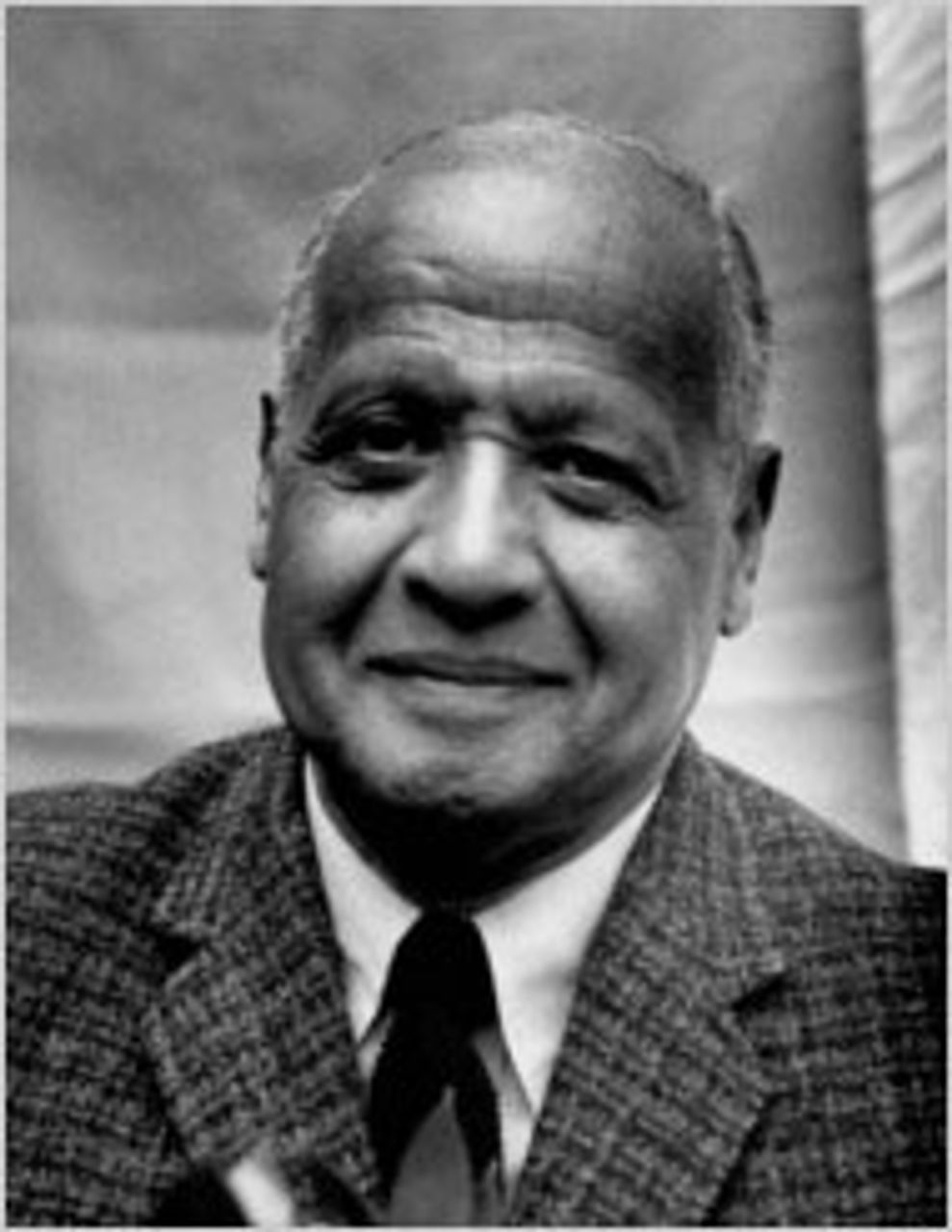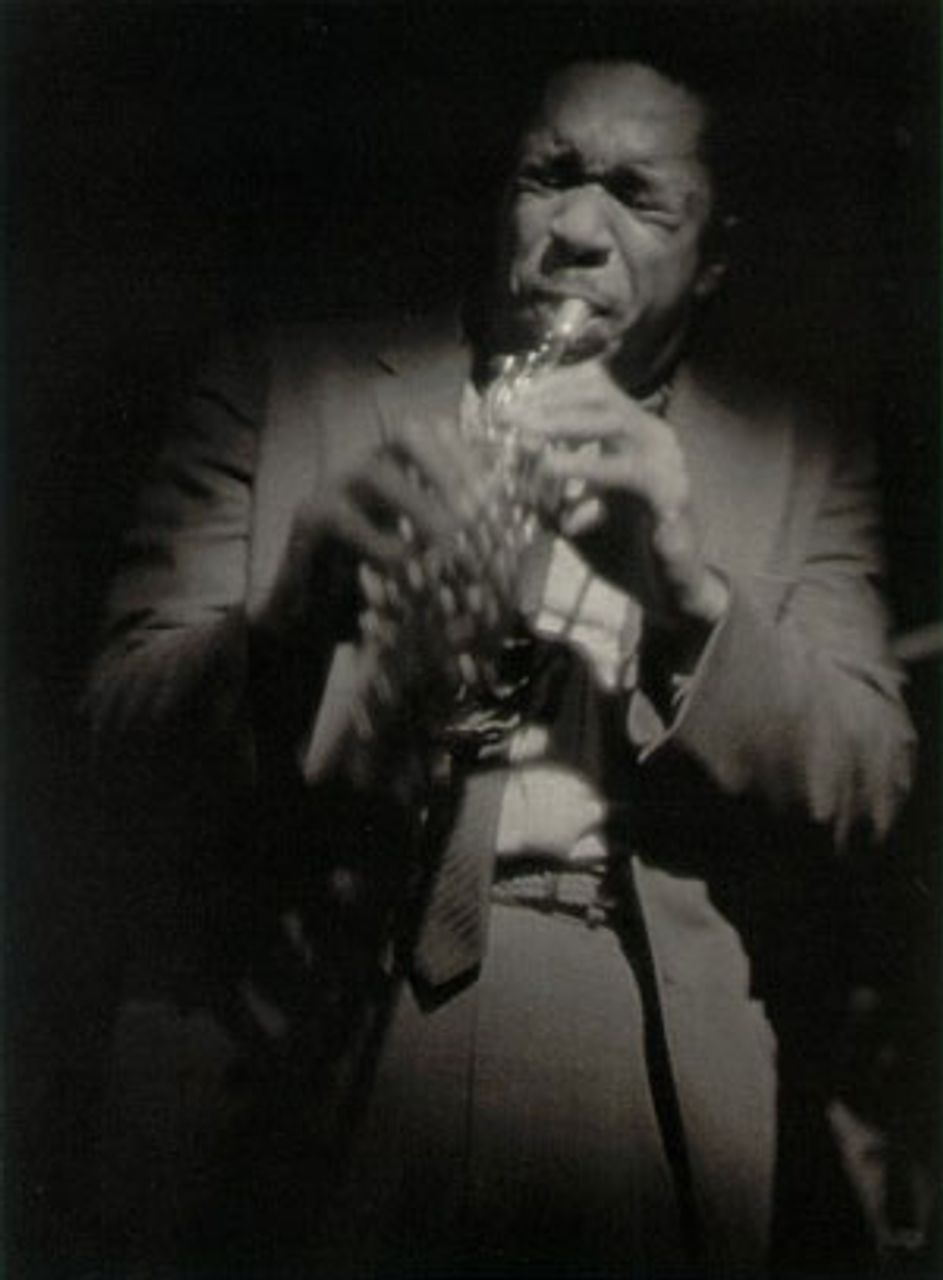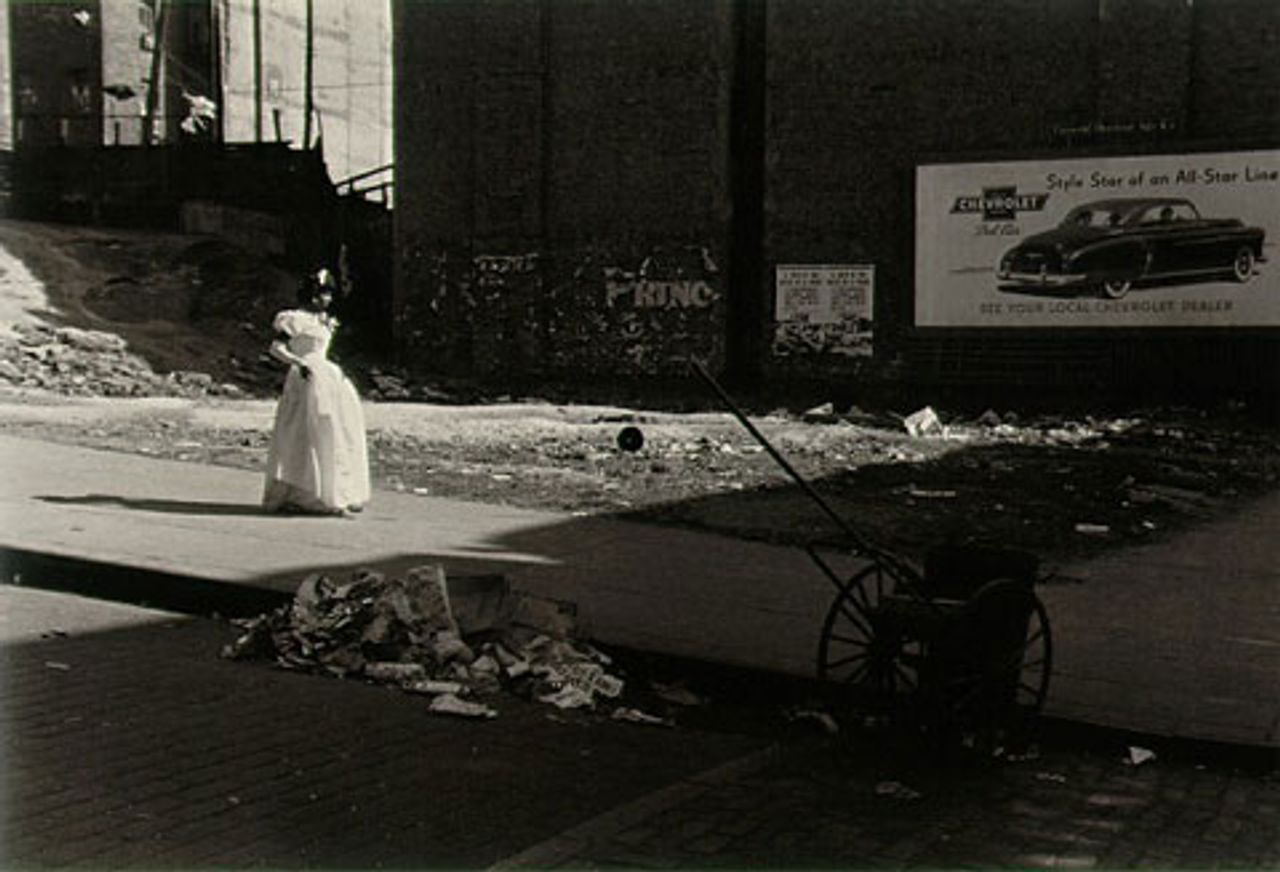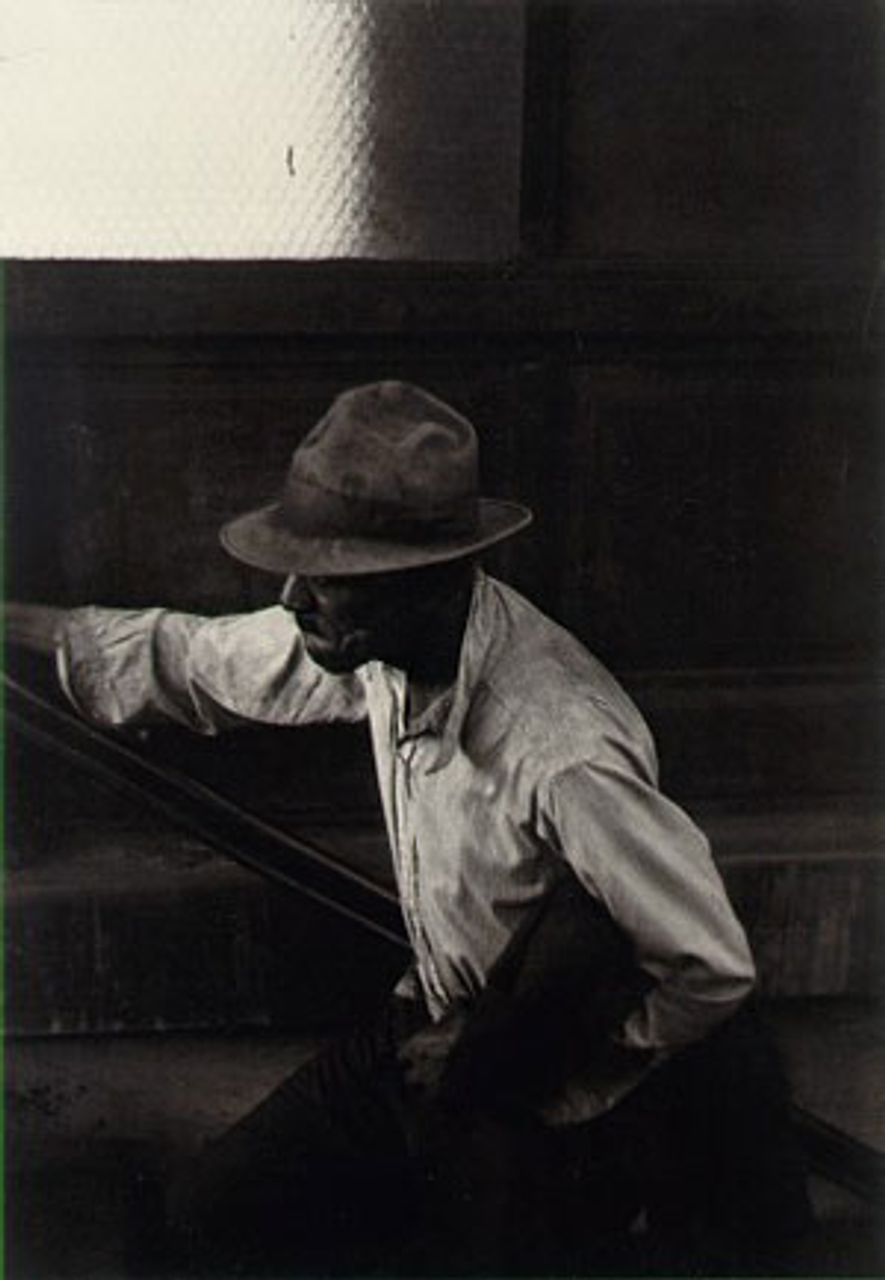 Portrait of Roy DeCarava by
Portrait of Roy DeCarava by Sherry Turner DeCarava - 1996
Roy DeCarava, one of the world’s most renowned photographers, died in October, six weeks shy of his 90th birthday. DeCarava was best known for his dark and sublimely textured portraits of American jazz musicians and for his intimate chronicling of everyday life in New York’s Harlem neighborhood in the two decades following the Second World War.
DeCarava’s photographic career spanned over half a century, beginning from the time he picked up the camera in the late 1940s. He began his creative career as a painter and printmaker, which included a brief period as a sign painter for the Works Progress Administration during the Depression. He started using the camera as a tool to assist his development in those media, but was quickly won over to photography as an art form.
 Portrait of John Coltrane - 1963
Portrait of John Coltrane - 1963From an insider’s point of view, he captured on black-and-white film the depth and richness of spirit of Harlem’s inhabitants, treating subject matter that ranged from fatigued workers on their way home, children playing in the streets, couples dancing, mothers caring for their children at home, picket lines and demonstrations in the midst of the struggles for civil rights, to the greats of New York jazz.
DeCarava was born in Harlem in December 1919. The area in the northern part of Manhattan was home to a growing black population, reaching about 30 percent of the total population by 1920. Raised as an only child by his single mother, an immigrant from Jamaica, he came of age during the period that is now commonly referred to as the “Harlem Renaissance,” a time of vibrant and growing artistic activity among African-Americans in the literary, musical, dramatic and visual arts.
As the name suggests, this artistic and intellectual ferment was centered, but not confined to Harlem, whose black population comprised over 70 percent of the total by 1930. His mother, recognizing the nascent artistic talents of her son at an early age, encouraged his interests in music and drawing. At the cost of several weeks pay she purchased a violin and lessons for him as a young grade school student.
 “Graduation” - 1949
“Graduation” - 1949Much of Harlem’s predominantly black population by 1930 originated as part of the “Great Migration” of African-Americans from the South in the early decades of the 20th Century. The new arrivals were seeking both employment in the Northern states’ rapidly expanding industrial centers and an escape from the overt and often violent racism that plagued the Jim Crow South. There were also, like DeCarava’s mother, immigrants from the Caribbean who came to New York and other northern cities seeking a better life.
The black migrants from the South brought with them their cultural and musical heritage, which by then included blues and jazz, and Harlem became home to musicians, writers, poets, actors, dancers, as well as visual artists. DeCarava developed a strong affinity for jazz and its principal practitioners—who would later become the subjects of his series “The Sound I Saw,” which included photographs of Duke Ellington, Billie Holliday, Ella Fitzgerald, and John Coltrane, among many other luminaries of the New York jazz scene.
As a boy DeCarava worked hard shining shoes, delivering bags of ice and newspapers, taking any odd job he could to help his family. He attended Chelsea Vocational High School and later received a scholarship to the Cooper Union, a prominent New York City art school. As one of the school’s few black students, DeCarava experienced alienation and felt that many of the white students were hostile to him. After two years he left to attend the Harlem Community Art Center on 125th Street where he studied printmaking.
DeCarava was soon after drafted into the US Army and served for a time as a topographical draftsman at a base in the South during the Second World War. After suffering what he later described as a nervous breakdown, partially resulting from the effects of the institutionalized racism of the Army, he ended up in an Army hospital for a period before receiving a medical discharge.
In a 1996 interview with National Public Radio (NPR), he discussed this period in his life. “It was so mean and destructive not only to me but to so many black soldiers, cause at the time, there were two armies—one was black, and one was white—and the only reason for the separation was to treat black people different from white people.” He added, “I didn’t like the idea of killing people—I didn’t like the idea of being killed—I didn’t like the whole destructive thing that the Army is made for….”
After this experience DeCarava returned to Harlem, first leaving painting for printmaking and then, by 1947, abandoning that, too, for photography. DeCarava’s early images of Harlem street life came to the attention of famed photographer Edward Steichen, then photography director at New York’s Museum Of Modern Art. Steichen encouraged him to apply for a Guggenheim fellowship. In 1952 he received the coveted grant, becoming the first African-American photographer ever to do so.
In his application statement DeCarava wrote of his desire “to show the strength, the wisdom, the dignity of the Negro people. Not the famous and well known, but the unknown and the unnamed, thus revealing the roots from which spring the greatness of all human beings” and to photograph the people of Harlem “morning, noon and night, at work, going to work, coming home from work, at play, in the streets, talking, kidding, laughing, in the home, in the playgrounds, in the schools, bars, stores, libraries, beauty parlors, churches, etc….”
 “Man Coming up Subway Stairs” - 1952
“Man Coming up Subway Stairs” - 1952DeCarava’s work, while in some respects similar to those of well-known contemporaries such as Helen Levitt, Bruce Davidson and Robert Frank, was more personal and less in the genre of photojournalism. Levitt, Frank and the others produced powerful images with an often deep and critical insight into American society. Their work, following the practices of the documentary photography up to that period, took aim at a society that appeared broken on many levels. The images were meant to arouse a feeling of concern and sometimes disgust with the status quo.
But none of this is immediately apparent in DeCarava’s images. He was, in many respects, one of the people he was photographing. He felt a deep kinship with his surroundings and wanted to make pictures that revealed a “gentle humanism”—a human warmth and closeness that he did not see anywhere else. He chose not to make overtly political pictures.
From a very early stage in his career he rejected the term “documentary” in relation to his work. He insisted that he was capturing a subject that contained, in his words, “a kind of literalness,” in which he “found something else that was strong and linked it up with a certain psychological aspect of my own,” he explained in Roy DeCarava, Photographs (1981). He was therefore producing a “creative expression” of truth, transcending mere reportage and becoming art.
DeCarava was indeed the first African-American photographer to set out to consciously document, in the form of art, the growing urban black environment. There were other black photographers before him, notably James Van Der Zee (1886-1983), who operated a portrait studio and took portraits of families and celebrated citizens in Harlem during the years of the “Harlem Renaissance,” and Gordon Parks (1912-2006), the famed photojournalist and writer perhaps best known for his photo-essays for Life magazine. His predecessors are noted for breaking the color bar in the field of documentary photography, but DeCarava is widely recognized for accomplishing the same in the realm of art photography.
In making the photograph, “Man Coming Up Subway Stairs,” DeCarava had conceived of the image ahead of time, scouted the appropriate location and stood and waited for the perfect subject and moment to coalesce. During the 1996 interview with NPR, he described the man who ended up in the picture: “He was perfect…he was determined to either to get home or get to the top of the stairs…he was tired.” He added, “these were the people who went to work every day—worked hard—and their lives were rather circumscribed…. I thought their consistency and their perseverance was in itself a heroic thing.”
The Guggenheim fellowship provided him with $3,200 (the equivalent of $25,000 today), a small fortune in 1952, which allowed him to work full-time for an entire year photographing the people of Harlem. DeCarava produced hundreds of photographs in this period, a large number of which were published in 1955 in The Sweet Flypaper of Life, a collaboration with Langston Hughes, who wrote a text organizing the photographs around a narrative of fictional characters centered on a grandmother called Sister Mary Bradley.
“It was almost clairvoyance the way he characterized the people in the photographs,” the photographer later said of Hughes’s ability to particularize each of the pictures and assign names and voices to the people in them, knowing nothing about them ahead of time but coming extraordinarily close to the voices and circumstances of the actual subjects.
Edward Steichen that same year decided to include several of DeCarava’s photographs in his landmark Museum of Modern Art photography exhibition “The Family of Man,” a group of some 500 images selected from nearly 2 million submissions, photographs depicting the lives of ordinary people around the world that later traveled to 38 countries and became a book of the same title that has sold 4 million copies in the last half century. DeCarava’s famous collaboration with Hughes, followed by the even more celebrated “The Family of Man,” brought him wide recognition.
Stylistically, DeCarava’s photographs found a consistency during this period that seemed to gravitate toward, rather than shy away from shadow and darkness. Densely shadowed areas within his frame would dominate at times only to be pierced with radiant highlights. He would also print down usually with very low contrast and at the low end of the tonal scale with details barely emerging from the shadow’s ink-like blacks. “I love the nuances in the dark image,” he told an interviewer in the late 1980s, “it’s not a blackness I’m seeking but a quality of light—the open dark—a sense of something there…. It’s not solid black, it’s not the conventional velvety black most photographers want—it’s air—space.”
The photographs are often imbued with an eerie calm and stillness. Peter Galassi, who took over as chief curator of photography at New York’s Museum of Modern Art in 1991 and organized the 1996 exhibition “Roy DeCarava, A Retrospective,” described the work in an introduction: “At the heart of DeCarava’s photography is a quiet contemplation…. DeCarava’s work achieves this reflective state of grace, in the way he looks at the world and the way his pictures invite us to look at them…. He loves the luxurious subtlety of photography’s infinitely divisible scale of grays, and it pleases him when viewers feel obliged to pause and peer closely into the dense but articulate shadows of his pictures…. Having paused, the viewer has entered into DeCarava’s world.”
In one of his best-known photographs, “Graduation,” we see a young girl in a white formal gown raked in sunlight while delicately walking down a Harlem sidewalk in the midst of a garbage-strewn empty lot and street engulfed in deep shadows with the silhouettes of objects peering out. Like many of his pictures, there is a lyrical sense of contradiction at work in the depiction of human activity that gives the work a significant social content.
Galassi added in his introduction to the retrospective: “The emotional intimacy of DeCarava’s photography is still more remarkable because it is full of social meaning: The expression of self is nearly always an expression of relation to others…. DeCarava is indeed a poet of light, but what is most distinctive and compelling in his art is the seamless, reciprocal identity of the personal and the social, as if each of these opposing aspects of the self had deepened the other.”
In the period following the success of The Sweet Flypaper of Life, DeCarava’s career entered something of a lull. He began taking on freelance assignments for magazines such as Life, Look, Fortune and Newsweek, which included travels to the South and to Washington, DC, to document the emerging struggles for civil rights in the 1960s.
In the 1950s DeCarava continued to document the jazz scene in New York. The Sound I Saw contained 196 of DeCarava’s photographs, interspersed with his own poetry, of the brightest stars of the jazz world. He created the prototype for this book in 1962, but it was not published until 2001.
DeCarava encountered racism and discrimination throughout much of his professional life, which accounts in part for the delay in his success and recognition in the art world. His views of society embodied these experiences, and he tended to see social and political phenomena in racial terms. He did not gravitate toward left-wing politics like many artists of his day, such as Langston Hughes.
DeCarava led a protest against Life magazine under the banner of the Committee to End Discrimination Against Black Photographers, and appealed to Gordon Parks to endorse it. Parks refused to do so and this led to a life-long split between the two photographers. While he rejected what he considered Parks’s accommodation to the status quo, however, DeCarava posed the issues narrowly.
He joined protests against the Metropolitan Museum of Art’s 1969 exhibition “Harlem on My Mind.” There was undoubtedly something healthy in DeCarava’s reaction to the establishment’s hypocritical adoption of civil rights rhetoric, but his main demand was that the museum include Harlem black civic leaders and artists in the show’s preparation.
The last decades of DeCarava’s life were increasingly occupied by teaching and the publication and promotion of his work. In 1975 he gave up all assignment work and took on a teaching position at New York’s Hunter College.
Roy DeCarava’s life as an artist left an indelible mark on America’s cultural and artistic history. His photographs revealed a side of black urban life that had hitherto been limited to social documentation on the one hand, and outright racial stereotyping on the other.
DeCarava was an artist deeply concerned and connected to the tumultuous struggles for progressive social change that surrounded him. His photographs of Harlem during the post-war period, including his now iconic images of the burgeoning New York jazz world, today provide a powerful and invaluable artistic and historic record of a remarkable chapter in American history.
